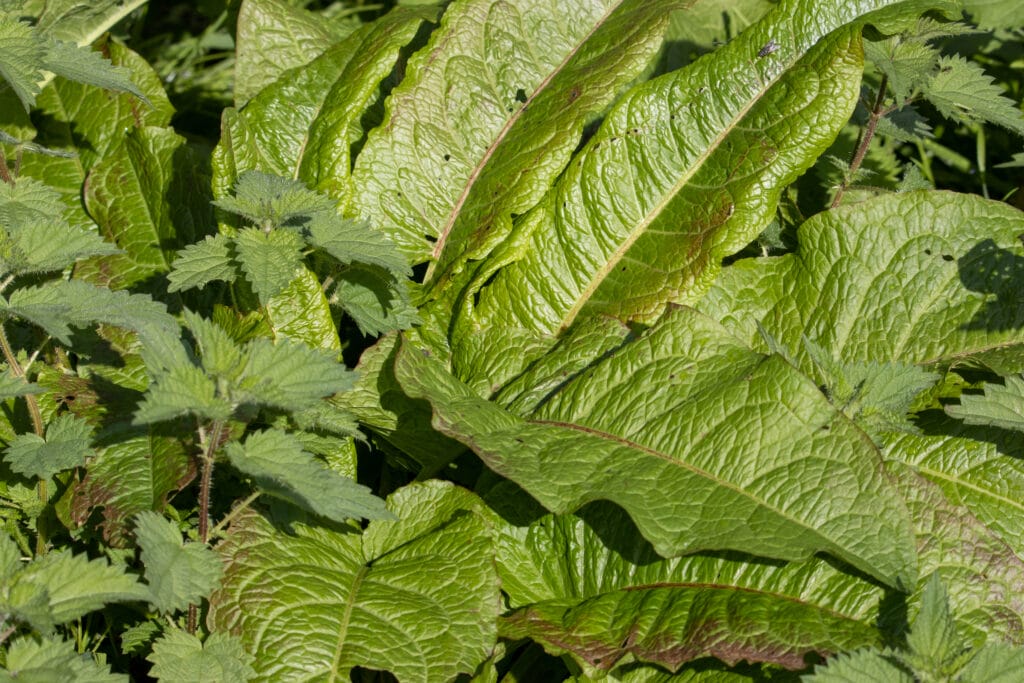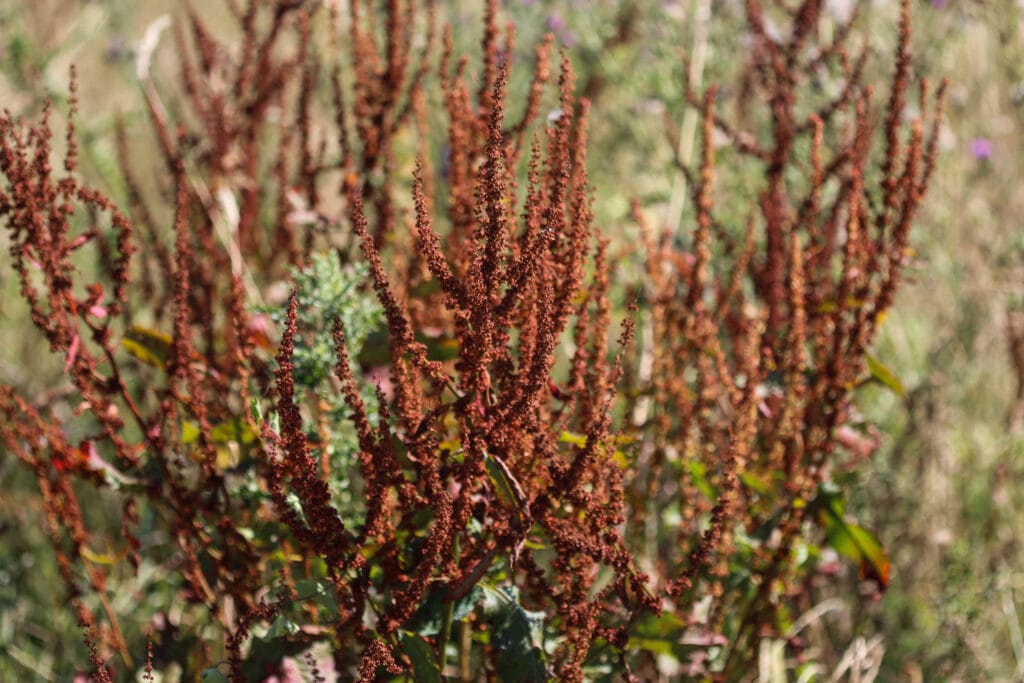Dock weeds are a familiar sight in the UK. They can be found everywhere from farmland and woodland through to waste ground, hedgerows and gardens. Generations of ramblers have long relied upon being able to identify a dock leaf to provide immediate relief for itchy nettle stings. But dock weeds are far less welcome for gardeners, having invasive qualities and being difficult to get rid of. And for farmers, it is important to put measures in place for curled and broad leaved dock control to prevent their spread. Broad-leaved dock (Rumex obtusifolius), also known as Bitter dock, and Curled dock (Rumex crispus) can spread quickly and have negative impact on farmland. Both can outcompete other species, and whilst not ‘highly’ poisonous to cattle, they are detrimental when consumed in large quantities.
Dock leaf identification
Dock plants can commonly be characterised by their simple, elongated green leaves, which exhibit different textures and contours according to the variety. Some have smooth leaves, whilst others are wavy or curled at the edges. Dock leaves are supported by stout, erect stems that can be herbaceous or robust, and often display a reddish hue. Docks have tiny flowers, usually with a greenish or reddish-brown tint, arranged in whorls on elongated stems. After flowering, hard, triangular or heart-shaped seeds are formed along seed spikes.
Once dispersed, seeds can lie dormant in soil for decades contributing to the spread and persistence of the plant. Below ground docks are just as tenacious, with a deep and thick taproot system. This enables their survival in diverse soil types and allows them to resist many control measures. The growth habit of docks includes a rosette stage, where the leaves forms circular pattern close to the ground, followed by flowering stems that shoot upwards as the plant matures.
Types of dock weeds in the UK
The two most prevalent varieties of dock weed in the UK are Broad-leaved dock and Curled dock. Both are widespread, can be found in similar environments and have invasive properties. Other notable species of UK dock include:
- Water dock (Rumex hydrolapathum): Typically found near water bodies such as rivers, ponds, and ditches. Water dock has large, broad leaves and can grow quite tall.
- Wood dock (Rumex sanguineus): Distinguished by its slender leaves and sometimes red veins. This species prefers woodland areas or shady locations.
- Clustered dock (Rumex conglomeratus): Characterised by its dense clusters of flowers, which are more tightly packed than in many other dock species. It prefers damp habitats, like meadows, streams, and wetland areas.

Close up of Broad-leaved dock (Rumex obtusifolius) pictured with nettles iStock/Ian Peter Morton
Unlike Bitter dock and Curly dock, these species are not listed as injurious in the Weeds Act (1959).
When distinguishing between species, a key dock identification factor is the appearance of the leaves. However, the two most widespread species, Broad leaved dock and Curled dock, have other differentiators that go beyond the shape of the leaves.
Broad-leaved dock
Broad-leaved, or Bitter, dock has a basal rosette of broad oval-shaped leaves. These can be up to 25cm long, and will have a strongly defined central vein with backward pointing lobes near the base. Stems are typically around 100cm high but can reach 150cm.
Bitter dock flowers from late June to October, producing multiple, loosely distributed clusters of flowers. After pollination these flowers turn into fruits, or achenes. This is a type of dry one-seeded fruit that is persistent and doesn’t open to release the seed when mature. The fruits are triangular to ovate in shape, with a distinctive toothed, wing-like structure at the edges. They are relatively small, only a few millimetres in diameter. The seed itself will be encased in perianth (part of the flower) that has become hardened into the tooth-edged wing structure for dispersal.
Dispersal
The slight winging of the perianth aids in the dispersal of the seeds by wind, water, or attachment to animals. However, seeds are also spread by human activity, particularly through the movement of soil or plant material from one location to another.

Tall seed spikes of Rumex obtusifolius laden with seeds iStock/michael meijer
Curled dock
Curled dock leaves are tapering with a wavy edge. They are narrower and more elongated than Broad-leaved dock. The plants are usually around 100cm high but can reach double that height. Typically, slightly smaller and less robust than Broad-leaved Dock, with a more elongated appearance due narrower leaves and less dense flower spikes.
Flowering also occurs from late June to October, but the clusters of flowers and seeds are more closely packed together than Broad-leaved dock. And, Curled dock fruit (achene) with their outer coating in the form of a valve, have a smooth edge, in contrast to the tooth edged fruits produced their cousin.
Habitats
Curly dock frequently shares the same environments as Broad-leaved dock. However, it is also often found in slightly drier, more disturbed soils – agricultural lands, roadsides, and waste areas.
Broad-leaved and Curled dock hybrids
Despite being distinct species, Curled Dock and Broad-leaved Dock are genetically compatible enough to produce viable offspring. The success of hybridisation varies, with some hybrids being more fertile and capable of further reproduction than others. These hybrids can be more persistent than the parent species, exhibiting variations in herbicide resistance, growth patterns, and ecological impacts.
Dock hybrids are relatively common in the UK, and their management can be more challenging than that of their parent species.
Broad-leaved dock uses
Broad-leaved dock is commonly regarded as a weed in many parts of the world. However, it is also been utilised for various traditional and practical applications:
- Skin Irritations: Traditionally used to soothe skin irritations, including nettle stings and insect bites. The juice from the leaves is applied to the affected area to relieve pain and itching.
- Anti-inflammatory: The plant has been used in folk medicine for its anti-inflammatory properties to treat issues such as minor burns, bruises, and sores.
- Digestive Aid: There are historical references to the use of broad-leaved dock in treating digestive problems, thanks to its mild laxative effect and potential to aid in bile production.
- Natural Dyes: The roots of broad-leaved dock have been used to produce a natural dye. The colour obtained can range from yellow to reddish-brown, depending on the mordant used.
Dock leaves and nettles
The medicinal qualities of dock leaves are well-known by walkers. Dock leaves commonly grow near nettles and can provide pain relief when rubbed on the sting. However, the reasons for this are still not known and it may even be a placebo effect.
Culinary uses
Dock leaves from both Broad leaved dock and Curled dock are edible and have culinary uses. Dock leaves can be eaten raw in a salad, dried to make a seasoning, or stewed with the stems. They also have good levels of Vitamin A and C. Traditionally, they were used to wrap butter to help preserve it.
However, caution must be applied as Dock leaves contain high levels of oxalic acid, which is toxic if consumed in large quantities. The leaves can also trigger asthma or hay fever.
N.B. Misidentification is a common risk when foraging for wild plants. Docks can be confused with other plants that are not edible or are toxic. It’s crucial to be 100% certain of the plant’s identity before consuming – always seek advice if uncertain.
Are Bitter dock and Curly dock invasive species?
In the UK, ‘invasive species’ is a term that has become associated with non-native plant and animal species, as listed in Schedule 9 of the Wildlife and Countryside Act (1981). Curled and Bitter dock are highly persistent, difficult to control and can outcompete other plant species. However, they are both established UK plants and, as they are considered native, wouldn’t fall into this legal definition.
Is bitter dock injurious?
Bitter dock is ‘injurious’ and certainly has the aggressive qualities of an invasive plant without being defined as such. In the UK it’s an injurious weed prescribed by the Weeds Act 1959. This Act also covers other injurious plants and the much need control of Ragwort. These are plants considered by the Minister of Agriculture, Fisheries and Food to be harmful to agriculture, the environment, or human or animal health. There is a legal obligation to prevent these weeds from spreading, particularly in relation to the threat they pose to neighbouring land.
Bitter dock spreads quickly and once established can be very difficult to eradicate, particularly as its seeds can survive in the soil for decades. It is also resistant to many common herbicides. The plant contains oxalic acid and tannins which, when ingested in significant amounts, can cause kidney damage and oxalate poisoning in livestock. Although, it is generally thought that cattle will choose alternatives if available.
Is Curly dock injurious?
Like Bitter dock, Curled dock, also known as Curly dock, is a listed injurious weed. Like its cousin, it’s also listed in the Weeds Act 1959, the 2nd of the two dock species present. Curly dock is similarly persistent, and its seeds can survive even longer in the soil – some say longer than 50 years. Consumption of large amounts by cattle can lead to oxalate poisoning; symptoms can include kidney damage, reduced calcium levels, and gastrointestinal irritation.
How does dock weed spread?
Dock weed primarily spreads through prolific its seeds, which is one of the reasons it can be so hard to eradicate. However, the tap roots of the plant also pose a challenge means to regenerate.
Dock weed seeds
Dock weed seeds are distributed in the same way many plant seeds are, through the wind or via water, as well as through animal faeces and even via machinery. It is not uncommon for Dock weed seeds to be found in manure that could then be subsequently spread when applied.
One of the main problems with both Bitter dock seeds and Curly dock seeds is that they are particularly abundant with a single plant producing thousands of seeds in a year. The seeds can also survive for several decades, meaning that dock weed can and will spread far and wide.
Dock leaf roots
Dock weeds, including both curled dock and broad-leaved dock, primarily spread via seeds. However, they also have a robust and deep taproot system which can send up new shoots if the root is broken. This differs from many invasive species that use their roots or stem-like structures for this purpose. This is the case with the most notorious invasive species, which spreads via Japanese knotweed rhizomes. Similarly to knotweed, docks can regenerate from root fragments left in the soil.
How to get rid of Broad-leaved dock
Overall, getting rid of Broad-leaved dock, Curly dock, or associated hybrids, can be difficult to achieve by yourself. Whilst action can be taken that may appear to have worked, the persistent nature of dock weed means it can return year after year if not treated thoroughly.
Excavation is possible, particularly during the spring. However, this is only really applicable for isolated specimens so treatment with herbicide is the best option in many cases.
Both Broad-leaved dock and Curled dock can be treated with the right herbicides during the active growth period, from spring through to autumn. If the docks are well established, the herbicide will need to be treated over several years to successfully control the dock infestation.
Because docks weeds are so persistent, assistance from a professional operator may be required, particularly if a large area needs to be dealt with. Look for professional organisations that specialise in dealing with invasive and injurious weeds, with the appropriate training and spraying qualifications.
At PBA Solutions, we deal with a wide range of injurious weeds and invasive plant species. We are always happy to offer dock identification assistance and offer advice on the best solutions to prevent it spreading. If you are concerned about how to get rid of Broad leaved dock, or require assistance with the control of Curly or Broad leaved dock, call 0203 174 2187 or 01202 816134 to talk to one of our consultants today.
Lead image: close up of Broad-leaved dock (Rumex obtusifolius) pictured with nettles
iStock/Ian Peter Morton

